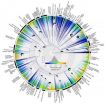(Press-News.org) A large proportion of aspen in the western U.S. sport an extra set of chromosomes in their cells, a phenomenon termed triploidy, according to new research published Oct. 31 in the open access journal PLoS ONE by Karen Mock from Utah State University and colleagues at several other institutions. In some areas of southern Utah and Colorado, over 60% of aspen trees are triploid.
Though triploid trees are not uncommon, this genetic anomaly can cause altered physical traits including sterility or reduced fertility. Although a triploid aspen clone may reproduce with root suckers, the scientists say, it is unlikely to produce viable seed.
Mapping the rates of triploidy in aspen to latitude, glacial history and regional variation in climate, the researchers found that these rates were highest in unglaciated, drought-prone regions. Wolf, professor in USU's Department of Biology, notes triploid plants often have larger cells, which might affect how plants cope with different conditions. "It is possible triploid aspen can better absorb water than diploids and are therefore better suited to withstand dry conditions, but they may be especially vulnerable to severe drought," he says.
Iconic fall foliage of the north-western forests, aspen populations have been declining in recent years; their high mortality rates have been attributed to drought, insect pests and a mysterious syndrome termed "Sudden Aspen Decline" (SAD). The new research is based on data collected over more than eight years by the Forest Service, a NASA Biodiversity program, and several researchers and volunteers.
Lead author on the study Mock says, "Though our findings come from many years of study, they provide an important starting point as we go forward. What we're learning will help us understand both the past and the future of aspen in the West."
INFORMATION:
Citation: Mock KE, Callahan CM, Islam-Faridi MN, Shaw JD, Rai HS, et al. (2012) Widespread Triploidy in Western North American Aspen (Populus tremuloides). PLoS ONE 7(10): e48406.doi:10.1371/journal.pone.0048406
Financial Disclosure: The authors thank the United States Department of Agriculture (USDA) Forest Inventory and Analysis Program, NASA Biodiversity Program, USDA National Research Initiative, USDA Natural Resource Conservation Service, Utah Agricultural Experiment Station, Utah State University (USU) Cedar Mountain Initiative, and USU ADVANCE program, and for financial support. The funders had no role in study design, data collection and analysis, decision to publish, or preparation of the manuscript.
Competing Interest Statement: The authors have declared that no competing interests exist.
PLEASE LINK TO THE SCIENTIFIC ARTICLE IN ONLINE VERSIONS OF YOUR REPORT (URL goes live after the embargo ends):
http://dx.plos.org/10.1371/journal.pone.0048406
Western aspen trees commonly carry extra set of chromosomes
Over 60 percent of aspen in parts of Utah, Colorado are triploid, new study shows
2012-11-01
ELSE PRESS RELEASES FROM THIS DATE:
Gut reaction: The evolution of IBD
2012-11-01
In one of the largest studies of its kind, researchers have identified 71 genetic regions newly associated with inflammatory bowel disease (IBD), increasing the total number discovered to date to 163. This new information reveals that there is a vast amount of genetic overlap between Crohn's disease and Ulcerative colitis (the two most common subtypes of IBD), suggesting that they share common biological pathways. In addition, analyzing these regions reveals that IBD may result from the body's immune response over-reacting, the result of a long-term evolutionary balancing ...
Do Australia's giant fire-dependent trees belong in the rainforest?
2012-11-01
Australia's giant eucalyptus trees are the tallest flowering plants on earth, yet their unique relationship with fire makes them a huge puzzle for ecologists. Now the first global assessment of these giants, published in New Phytologist, seeks to end a century of debate over the species' classification, a debate which may determine their future.
Gigantic trees are as rare as they are awe inspiring. Of the 100,000 global tree species only 50, less than 0.005%, reach over 70 meters in height. While many of these giants live in Pacific North America, Borneo and similar habitats, ...
New MS drug proves effective where others have failed
2012-11-01
A drug which 'reboots' a person's immune system has been shown to be an effective treatment for multiple sclerosis (MS) patients who have already failed to respond to the first drug with which they were treated (a 'first-line' therapy), as well as affected individuals who were previously untreated. The results of these two phase III clinical trials were published today in the journal The Lancet.
The new studies, sponsored by Genzyme (a Sanofi company) and Bayer Schering Pharma, showed that alemtuzumab significantly reduces the number of attacks (or relapses) experienced ...
Excess nitrogen fertilizer increasing warming in China
2012-11-01
Halving the amount of nitrogen fertiliser used in certain areas of China would substantially decrease greenhouse gas emissions without affecting crop productivity and the area's natural carbon sink.
This is according to a new study, published today, 1 November, in IOP Publishing's Environmental Research Letters, which showed that a 60 per cent reduction in fertiliser use would significantly reduce emissions from areas that are, anyway, "over-fertilised", such as the North China Plain and middle and lower reaches of the Yangtze River Basin.
China is currently tasked ...
1000 genomes study is 'guidebook' to how genes vary
2012-11-01
A landmark project that has sequenced 1,092 human genomes from individuals around the world will help researchers to interpret the genetic changes in people with disease.
The first study to break the '1000 genomes barrier' will enable scientists to begin to examine genetic variations at the scale of the populations of individual countries, as well as guiding them in their search for the rare genetic variations related to many diseases.
The vast majority of genetic variation is shared with populations around the world but it is thought that a lot of the contribution ...
When people worry about math, the brain feels the pain
2012-11-01
When people worry about math, the brain feels the pain
Mathematics anxiety can prompt a response in the brain similar to when a person experiences physical pain, according to new research at the University of Chicago.
Using brain scans, scholars determined that the brain areas active when highly math-anxious people prepare to do math overlap with the same brain areas that register the threat of bodily harm—and in some cases, physical pain.
"For someone who has math anxiety, the anticipation of doing math prompts a similar brain reaction as when they experience pain—say, ...
Patients with diabetes left in the dark
2012-11-01
Patients newly diagnosed with type 2 diabetes feel "left in the dark" and unsure what they can and can't eat whilst sometimes waiting months to receive diabetes education, according to a new study published online today in the journal Primary Health Care Research & Development (1). The research carried out by Dr Michelle McKinley and colleagues at Queen's University Belfast, explored the views of people recently diagnosed with diabetes and discovered that whilst waiting for a referral to a diabetes education programme, they received little or no information about what to ...
Alcohol increases activity of the resting brain in social drinkers
2012-11-01
Short-term alcohol intake can increase the activity of functional connections across the human brain when it is at rest, according to research published Oct 31 in the open access journal PLOS ONE by Panagiotis Bamidis and colleagues from the Aristotle University of Thessaloniki, Greece.
Previous studies have shown that alcohol intake increases transmission of signals by the neurotransmitter GABA, present in 40% of the connections between nerve cells in the brain. Here, the researchers monitored resting brain activity in healthy social drinkers who had consumed one drink, ...
Exhaustive family tree for birds shows recent, rapid diversification
2012-11-01
New Haven, Conn. — A Yale-led scientific team has produced the most comprehensive family tree for birds to date, connecting all living bird species — nearly 10,000 in total — and revealing surprising new details about their evolutionary history and its geographic context.
Analysis of the family tree shows when and where birds diversified — and that birds' diversification rate has increased over the last 50 million years, challenging the conventional wisdom of biodiversity experts.
"It's the first time that we have — for such a large group of species and with such a ...
First ever family tree for all living birds reveals evolution and diversification
2012-11-01
The world's first family tree linking all living bids and revealing when and where they evolved and diversified since dinosaurs walked the earth has been created by scientists from the University of Sheffield.
Experts used the family tree to map out where the almost 10,000 species of birds live to show where the most diversification has taken place in the world.
Researchers, from the University of Sheffield, Yale University, University of Tasmania and Simon Fraser University, say the creation of new species has speeded-up over the last 50 million years. Surprisingly, ...
LAST 30 PRESS RELEASES:
Palaeontology: Ancient tooth suggests ocean predator could hunt in rivers
Polar bears may be adapting to survive warmer climates, says study
Canadian wildfire smoke worsened pediatric asthma in US Northeast: UVM study
New UBCO research challenges traditional teen suicide prevention models
Diversity language in US medical research agency grants declined 25% since 2024
Concern over growing use of AI chatbots to stave off loneliness
Biomedical authors often call a reference “recent” — even when it is decades old, analysis shows
The Lancet: New single dose oral treatment for gonorrhoea effectively combats drug-resistant infections, trial finds
Proton therapy shows survival benefit in Phase III trial for patients with head and neck cancers
Blood test reveals prognosis after cardiac arrest
UBCO study finds microdosing can temporarily improve mood, creativity
An ECOG-ACRIN imaging study solves a long-standing gap in metastatic breast cancer research and care: accurately measuring treatment response in patients with bone metastases
Cleveland Clinic presents final results of phase 1 clinical trial of preventive breast cancer vaccine study
Nationally renowned anesthesiology physician-scientist and clinical operations leader David Mintz, MD, PhD, named Chair of the Department of Anesthesiology at the UM School of Medicine
Clean water access improves child health in Mozambique, study shows
Study implicates enzyme in neurodegenerative conditions
Tufts professor named Fellow of the National Academy of Inventors
Tiny new device could enable giant future quantum computers
Tracing a path through photosynthesis to food security
First patient in Arizona treated with new immune-cell therapy at HonorHealth Research Institute
Studies investigate how AI can aid clinicians in analyzing medical images
Researchers pitch strategies to identify potential fraudulent participants in online qualitative research
Sweeping study shows similar genetic factors underlie multiple psychiatric disorders
How extreme weather events affect agricultural trade between US states
Smallholder farms maintain strong pollinator diversity – even when far from forests
Price of a bot army revealed across hundreds of online platforms worldwide – from TikTok to Amazon
Warblers borrow color-related genes from evolutionary neighbors, study finds
Heat signaling from plants is an ancient pollinator signal
New index reveals the economics underlying the online manipulation economy
High-resolution satellite observations reveal facility-level methane emissions worldwide
[Press-News.org] Western aspen trees commonly carry extra set of chromosomesOver 60 percent of aspen in parts of Utah, Colorado are triploid, new study shows

